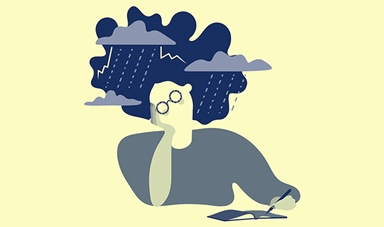Loading component...
At a glance
Mental health disorders are the leading cause of work disability and estimated to cost the global economy up to A$23 trillion by 2030.
“Claims for workplace compensation around mental health issues are on average more costly and require more days absent than any other type of workplace injury,” says Dr Gavin Brown, a clinical psychologist who offers resilience programs designed to deliver mental health and wellbeing concepts in a business environment.
According to global expert on workplace health Dr Tyler Amell, chief relationship officer at CoreHealth Technologies, poor mental health in the workplace can directly trigger physical health problems, heightening unproductivity or presenteeism (sick workers at work) and absenteeism.
Presenteeism costs Australian organisations A$34 billion a year, while the direct cost of paid time off, including sick leave and holiday leave, as a percentage of payroll, ranges from 12.2 per cent in China to 12.3 per cent in Europe.
Contrast these figures against the return on investment (ROI) in wellness for employees. PwC research has found that every dollar spent creating a mentally healthy workplace can, on average, generate a return of A$2.30.
Understand the problem
However, before a presenteeism or absenteeism problem can be addressed, you need to know the extent of it.
“Encourage your managers to report how many days they lose to stress-related sickness and absences each year,” Amell suggests.
“Real time absence reporting gives organisations greater visibility of their teams’ health and can influence when leaders might step in, improving early intervention. The internal data gathered from this reporting can also provide the evidence to invest in worker health and productivity programs.”
Brown says mental health challenges can arise from one of four domains: organisational – the culture and policies of an organisation as a whole; task demands – responsibilities as well as workload; interpersonal – the quality of workplace relationships and nature of conflict; and intrapersonal – the individual’s personality and coping style.
Build resilience
No matter what the stressor, Brown says most people want to enjoy their work and will be psychologically healthier, more motivated and productive if they do.
However, with rapidly changing work environments, increased pressure to meet deadlines and budgets, longer hours and conflict in relationships, a certain kind of toughness is required.
Psychologist and author of Stand Out, Alison Hill says managers can help staff become more resilient by empathising with their experience and reconnecting them to the two key drivers of change: purpose and progress.
"Encourage your managers to report how many days they lose to stress related sickness and absences each year."
“Purpose is what the company is trying to achieve while progress maps out the next steps, both for [staff members] personally and the people around them,” Hill says.
“Resilience grows when your staff feel supported and take ownership of what to do next.”
For those overwhelmed by the job at hand, making sure leaders have appropriate training to help colleagues in need before a crisis occurs is smart business, Amell adds. Remember that self-care is vital to mental health and implement initiatives that encourage or build on this.
These might include offering healthier food at work, discounted gym memberships, massages or free exercise classes, a company counselling service, or even telecommuting for those who want more flexibility.
Consult an expert
Many wellness experts offer services to corporate workplaces to improve employees’ physical and mental health. Such people can range from nutritionists to life strategists or corporate wellness coaches.
Their services include coaching and mentoring programs, mental health first aid and education, wellbeing checks and advice and resilience training.
Further, workplace rehabilitation providers can help employees who have sustained a work-related physical or mental injury recover and return to work.
The majority of Australia’s 2.17 million businesses are legally required to hold mandatory workers’ compensation insurance – costing them more than A$10 billion every year – which ensures access to a workplace rehabilitation provider, according to the Australian Rehabilitation Providers Association.
Smart apps to the rescue
Make sure you are giving your team access to digital tools, dashboards, resilience monitors or wellbeing apps so they can monitor their own mental health, Amell says.
According to the Black Dog Institute, online tools and apps such as Snapshot and myCompass are increasing access to online therapy and support, with the benefit of 24/7 availability and anonymity.
In addition, beyondblue's workplace mental health e-learning program aims to raise awareness of signs and symptoms of depression and anxiety, and where to get help.
Other apps that can improve self-care include:
Calm: a meditation app for beginners, the intermediate and advanced.
Happify: Boost your optimism, conquer negative thoughts and repattern stress with science-based activities and games.
Relax & Sleep Well: a 25-minute audio session with peaceful background music and sounds from nature to help you relax.
7 Minute Workout: no equipment needed to stay fit, in seven minutes a day.

